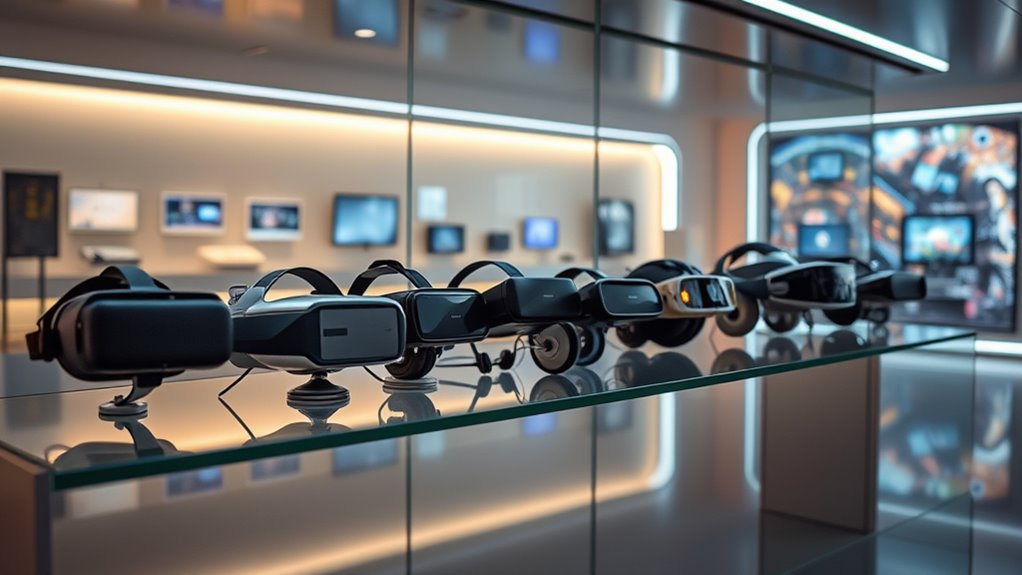VR headsets evolved through a fascinating timeline. It all began in the 1960s with Morton Heilig’s Sensorama, paving the way for immersive experiences. The 1990s and early 2000s saw the first consumer headsets emerge, thanks to advances in graphics and motion tracking. The 2010s marked a resurgence in innovation, expanding VR’s applications beyond gaming into education and healthcare. To uncover more about this rich history and future, you’ll find plenty of intriguing details ahead.
The Birth of Virtual Reality: Early Concepts and Prototypes
Although the concept of virtual reality (VR) seems modern, its roots trace back to the mid-20th century, when innovators began experimenting with immersive technologies. Early experiments laid the groundwork for what would become a revolutionary field. Pioneers like Morton Heilig crafted the Sensorama in the 1960s, a multisensory device that provided a glimpse into the potential of VR. These conceptual designs pushed boundaries, merging film with tactile sensations, thereby immersing users in experiences previously confined to imagination. The ambition of these innovators was to expand human perception and create a sense of presence in virtual spaces. As you explore this fascinating journey, consider how these foundational ideas paved the way for future advancements in VR, ultimately shaping the technology you interact with today.
The Rise of the First Consumer VR Headsets
As technology advanced in the late 20th and early 21st centuries, the dream of virtual reality shifted from experimental prototypes to viable consumer products. The emergence of the first consumer VR headsets marked a pivotal moment in VR gaming. Companies like Oculus and HTC began to refine their designs, emphasizing user-friendly interfaces and immersive experiences. You saw a surge in interest as these headsets became accessible to the general public, enabling gamers to step into vast virtual worlds. With advancements in graphics and motion tracking, the experience became more engaging. This era not only democratized VR but also laid the foundation for future innovations, ultimately transforming how you engage with digital entertainment and redefining the boundaries of gaming.
Technological Advances in VR: The 1990s to 2000s
During the 1990s to 2000s, significant technological advances propelled virtual reality closer to mainstream viability, transforming the way you perceive immersive experiences. Innovations in VR gaming emerged, focusing on 3D graphics and motion tracking. User interfaces also evolved, creating a more intuitive interaction with virtual environments. However, hardware limitations still challenged developers, restricting the fidelity of sensory feedback and immersion.
| Key Advances | Description |
|---|---|
| 3D Graphics | Enhanced visual realism |
| Motion Tracking | Improved user movement accuracy |
| User Interfaces | More intuitive controls |
| Software Development | Expanded VR applications |
These foundational elements laid the groundwork for future VR advancements while highlighting the balance between aspiration and existing technological constraints.
The Resurgence of VR: Innovations of the 2010s
The 2010s marked a pivotal resurgence in virtual reality, driven by a confluence of technological innovations that finally addressed the limitations of earlier decades. This era released immersive experiences that captivated users, particularly within the gaming revolution. Popular platforms like Oculus Rift and HTC Vive brought high-fidelity graphics and intuitive controls, allowing you to plunge into virtual worlds like never before. Beyond gaming, VR found applications in education, enhancing learning through interactive simulations and virtual field trips. These innovations also fostered new social interactions, enabling users to connect in shared virtual spaces. As VR technology evolved, it paved the way for a more engaging and versatile medium, sparking a renewed interest in its potential across various fields.
The Current State and Future of VR Technology
Recent advancements have transformed VR technology into a multifaceted tool, expanding its influence beyond gaming into various sectors like healthcare, business, and social interaction. You’ll find that immersive experiences now cater not just to gaming applications, but also serve as crucial educational tools, enhancing learning through simulated environments. In healthcare, VR uses are revolutionizing patient treatments and training for medical professionals, improving outcomes and understanding. Additionally, industrial training programs are leveraging VR to provide realistic simulations, ensuring employees can practice skills safely. Social interactions have evolved too, with virtual spaces allowing people to connect regardless of physical distance. As these developments continue, the future of VR could redefine how we learn, work, and engage with each other.
Frequently Asked Questions
Who Were the Key Inventors Behind Early VR Technology?
The key inventors behind early VR technology include Ivan Sutherland and Jaron Lanier. Their contributions marked significant VR breakthroughs, paving the way for future innovations and inspiring a generation of creators committed to exploring virtual environments.
How Did VR Technology Evolve in Gaming?
Virtual reality’s journey in gaming’s like a thrilling rollercoaster, weaving immersive experiences. As technology advanced, VR evolved from simple simulations to rich, interactive worlds, revolutionizing gameplay and granting players unprecedented freedom to explore and connect.
What Industries Currently Use VR Technology?
You’re seeing VR tech utilized in various industries, particularly in education applications for immersive learning experiences and military training for realistic simulations. This technology enhances skills and understanding, granting users greater freedom in their respective fields.
Are There Health Risks Associated With VR Headset Use?
Yes, there’re health risks with VR headset use. You might experience motion sickness or eye strain after prolonged sessions. Balancing immersion and well-being’s essential, so take breaks to enjoy the freedom VR offers without discomfort.
How Much Do Modern VR Headsets Typically Cost?
Modern VR headsets typically range from $200 for budget options to over $1,000 for premium models. Your choice depends on desired features, performance, and how immersive you want your virtual experiences to be.

